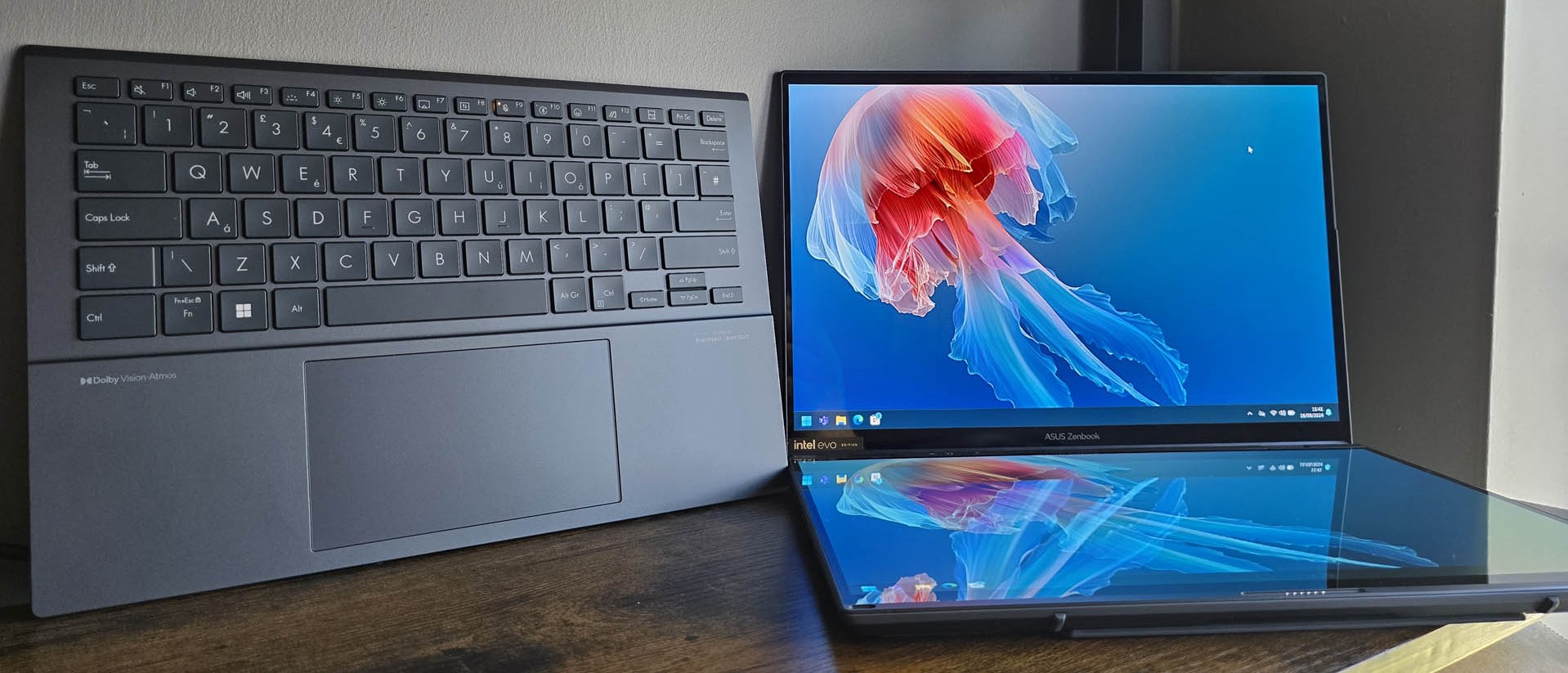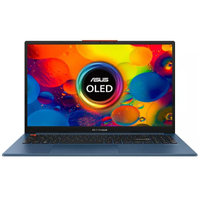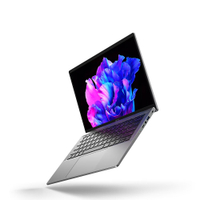TechRadar Verdict
There’s a lot to like about the latest Asus Zenbook Duo. Its incredible design, mixed with two outstanding displays, makes it a solid bet for those looking for a premium laptop. Combine that with an Intel Core Ultra 9 CPU, a 2TB PCIe 4.0 SSD, plus 32GB of DDR5 at some seriously top-tier speeds, and the Duo quickly feels like a no-nonsense productivity machine. That feeling evaporates, however, if you confront this laptop with any serious content creation task or benchmark that lasts longer than a minute. In this case, the wheels fall off, with the CPU being massively hindered by the limited cooling capacity in the Zenbook itself.
Pros
- +
Exceptional OLED displays
- +
Device versatility is phenomenal
- +
Battery life is solid for Intel
Cons
- -
Can’t compete with Arm-based devices
- -
CPU heavily limited by cooling
- -
SSD performance is underwhelming
Why you can trust TechRadar
Asus Zenbook Duo (2024): Two-minute review
The Zenbook Duo has always been a bit of a curious laptop. These Asus portables lie on the fringes of what you’d expect from high-end premium notebooks, bringing something of a gimmick to the forefront to differentiate the Zenbook.
For the uninitiated, the Duo in the name refers to the fact that this Zenbook packs two separate screens. Now this specific edition for 2024 has twin OLED panels, both offering a 2,880 x 1,800 resolution at a 120Hz refresh rate. Both screens are 14 inches, and both are fixed together, with the laptop’s internal hardware interlinked between the two displays. Keyboard and mouse support is provided by a Bluetooth solution that can simultaneously pseudo “wirelessly” charge off the bottom display as well (there’s a pin connector basically).
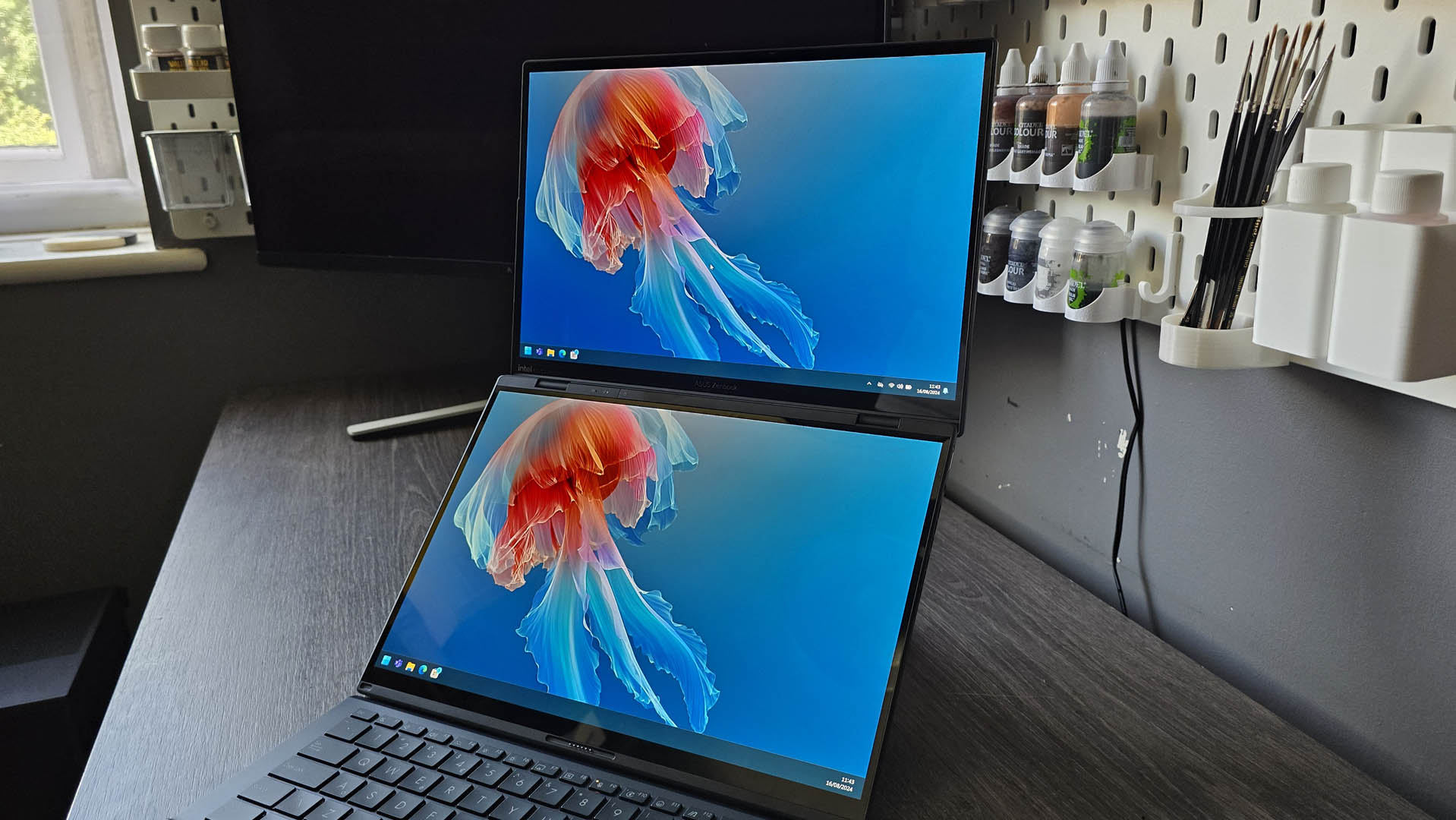
It’s a very different laptop design, then, and one that brings some major caveats with it. In particular, cooling with the Zenbook Duo takes a hit because of the real-estate that those twin screens take up, and the need for this device to be relatively thin. Higher spec models of the Zenbook Duo (2024), like the one we’re reviewing here, are decent enough in short-term bursts of activity, but struggle with any form of prolonged and demanding CPU workloads. Gaming in particular feels sluggish and is often on the verge of being unplayable, even at 1080p resolution with medium settings.
Still, pricing isn’t entirely unreasonable. In the US the Zenbook Duo (2024) retails on average for around $1,829, and in the UK about £2,000 or so, and you get some serious hardware in the laptop. It is, however, still more of a MacBook alternative rather than a serious work machine, and certainly not one of the best laptops around. For that, you’ll need to look at the Asus Zenbook Pro instead.
Asus Zenbook Duo (2024): Price and availability
- How much does it cost? $1,829 / £2,000 / AU$3,599
- When is it available? It's on sale now
- Where can you get it? Newegg in the US, Currys in the UK, and leading retailers in Australia
At least on the surface, the Zenbook Duo appears to be remarkably good value for money. In our review model, Asus crammed in an Intel Core Ultra 9 185H (Meteor Lake) processor with six performance cores, eight efficiency cores and two low-power cores (22-threads in total). This CPU has a rated maximum clock speed of 5.1GHz, and sports a dedicated NPU (Neural Processing Unit) for accelerating AI tasks. You get 32GB of LPDDR5X RAM (soldered, of course), and for storage you’re looking at a 2TB PCIe 4.0 SSD.
The biggest selling point, though, has to be those twin OLED displays. They’re vibrant, punchy, and really do make this laptop a joy to use, helping to justify the price tag.
There are a number of different Zenbook Duo (2024) models out there right now, and you can pick up one with a Core Ultra 7 processor, and a 1TB SSD plus 16GB of LPDDR5X RAM for a lot less than our review model here. Although be warned that in some locations (like the US), the lower-end variant does come with lower resolution (1200p) screens with a 60Hz refresh rate. Whereas in Australia, the Ultra 7 variant has the same excellent 2880 x 1800 OLED panels as the Ultra 9 model.
- Price: 4 / 5
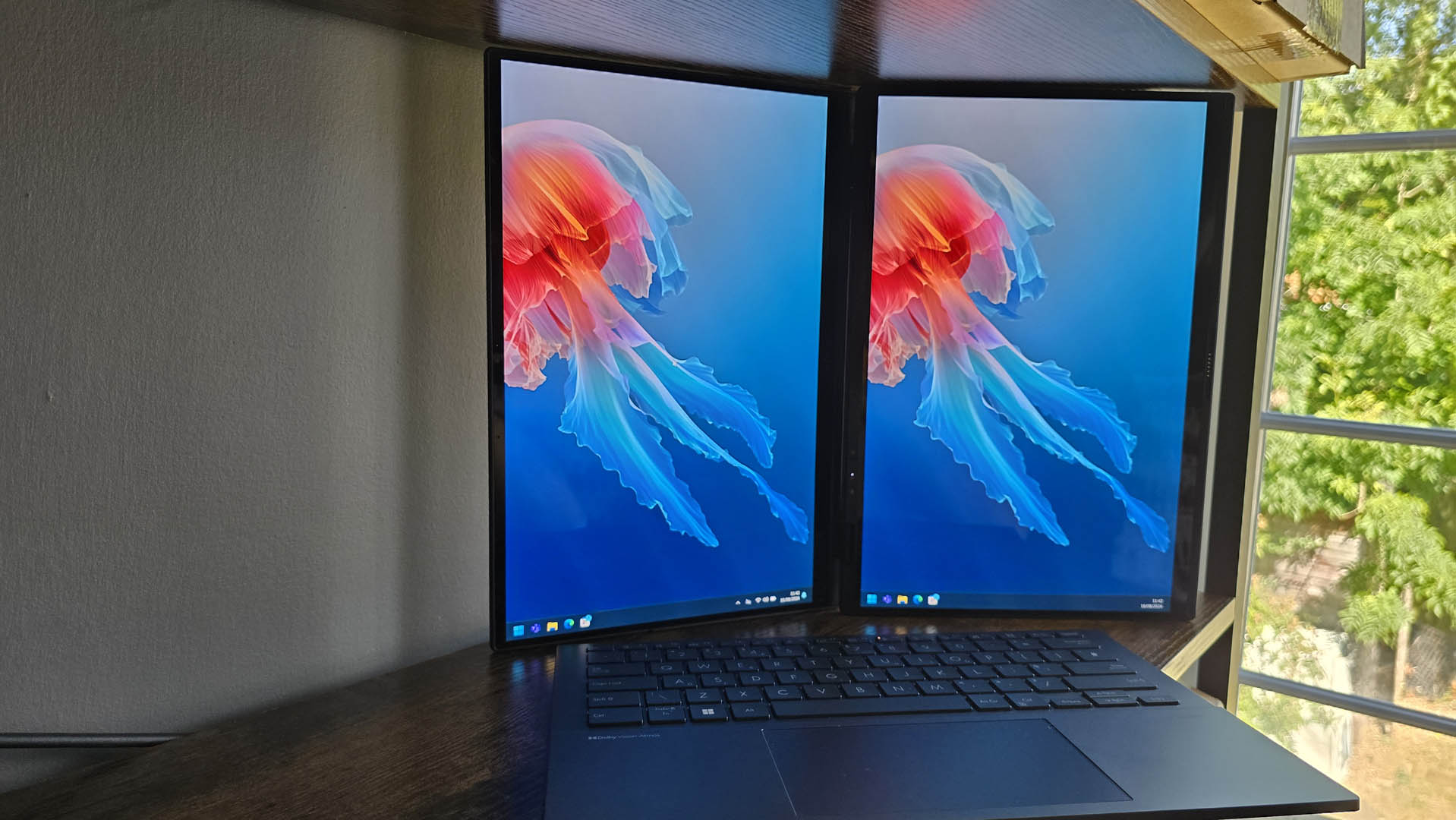
Asus Zenbook Duo (2024): Specs
Here are the specs for the Asus Zenbook Duo (2024) at a glance.
| Header Cell - Column 0 | Base Model | Review Unit |
|---|---|---|
| Price | $1,499 / £1,699 / AU$3,599 | $1,829 / £2,000 / AU$3,999 |
| CPU | Intel Core Ultra 7 155H | Intel Core Ultra 9 185H |
| GPU | Integrated Intel Arc Graphics | Integrated Intel Arc Graphics |
| RAM | 16GB LPDDR5X | 32GB LPDDR5X |
| Display | 2 x 14-inch 1,920 x 1,200, OLED, 500 nits, 60Hz | 2 x 14-inch 2,880 x 1,800, OLED, 500 nits, 120Hz |
| Storage | 1TB WD SN740 PCIe 4.0 SSD | 2TB WD SN740 PCIe 4.0 SSD |
| Ports | 2x Thunderbolt 4, 1x USB-A, 1x HDMI 2.1, 1x 3.5mm audio jack | 2x Thunderbolt 4, 1x USB-A, 1x HDMI 2.1, 1x 3.5mm audio jack |
| Wireless | Wi-Fi 6E, Bluetooth v5.3 | Wi-Fi 6E, Bluetooth v5.3 |
| Weight | 3.2lbs / 1.45kg | 3.2lbs / 1.45kg |
| Dimensions | 217.9 x 313.5 x 21.3mm | 217.9 x 313.5 x 21.3mm |
Asus Zenbook Duo (2024): Design
- OLED screens are phenomenal
- It all feels impressively premium
- Some interesting hardware decisions
Okay, let me be clear here. I’ve been testing laptops for years, and have toyed around with a number of top-tier premium solutions, many of which have been Asus devices. The Zenbook Duo, from a purely physical perspective, is an absolutely outstanding notebook. Those dual screens are beautifully crisp, with an impressive response time (7.6ms MPRT when tested), and a buttery smooth refresh rate to cap it all. They’re bright, colorful, and gorgeous to behold.
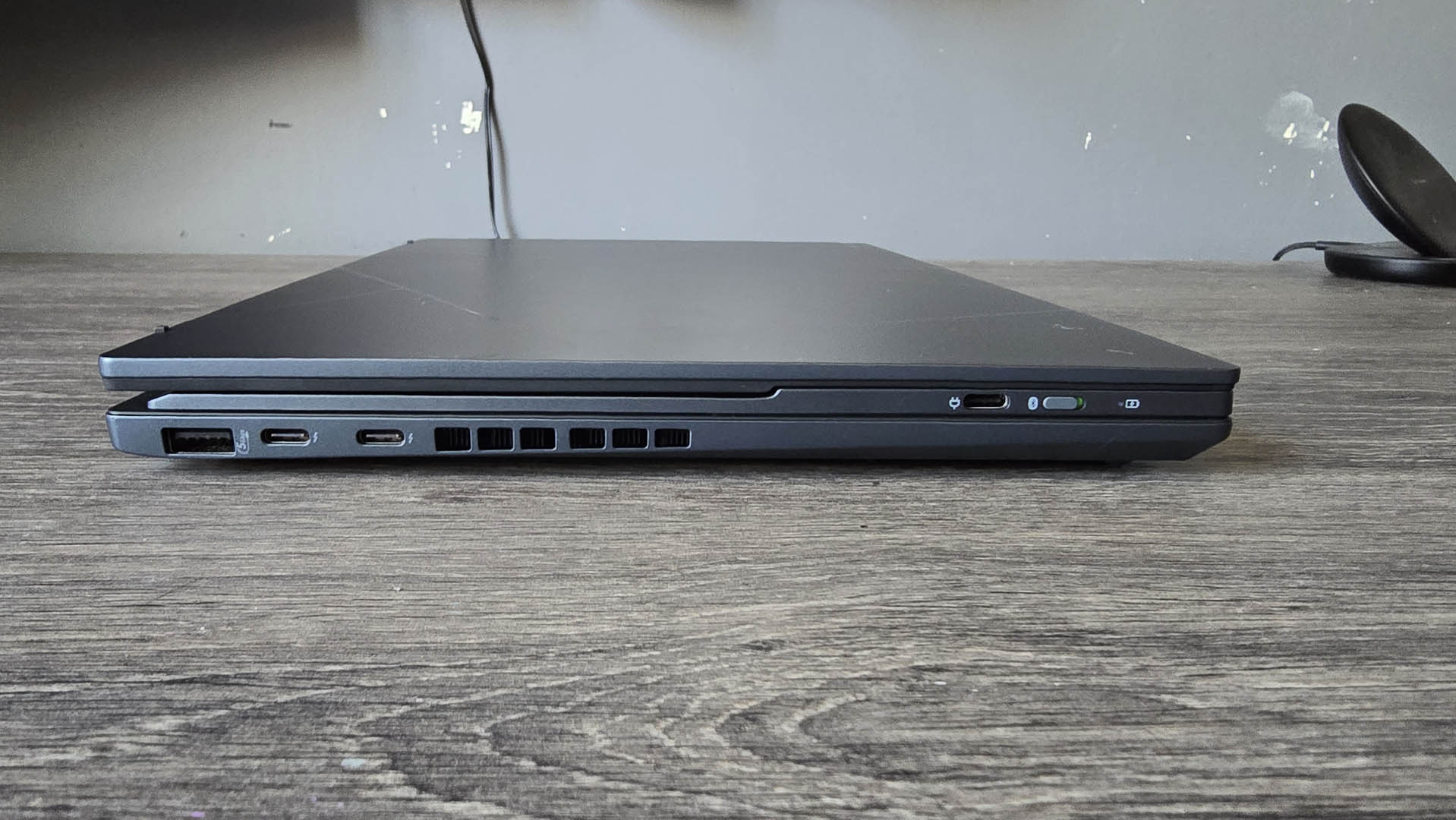
The Duo’s not short on ports either, certainly not for a slim laptop. You get two USB Type-C, one USB-A (rated at 5Gbps), HDMI out, and a 4-pole 3.5mm analog jack as well. The keyboard (plus trackpad) is a Bluetooth affair, and, although not exactly thrilling with a simple design, it’s got an impressive battery life, and connects seamlessly to the Duo via magnets (and also charges pseudo-wirelessly via a pogo-pin off the Zenbook, as well).
The internal hardware is a little bit on the curious side, however. This particular model comes with the Intel Core Ultra 9 185H, which is quite a thirsty – and toasty – chip. It has an NPU built in, making the processor somewhat more potent at handling AI operations (although nowhere near as powerful as a dedicated GPU), but it does require some serious cooling to keep all that potency in check. I’ll talk a little bit more about that later.
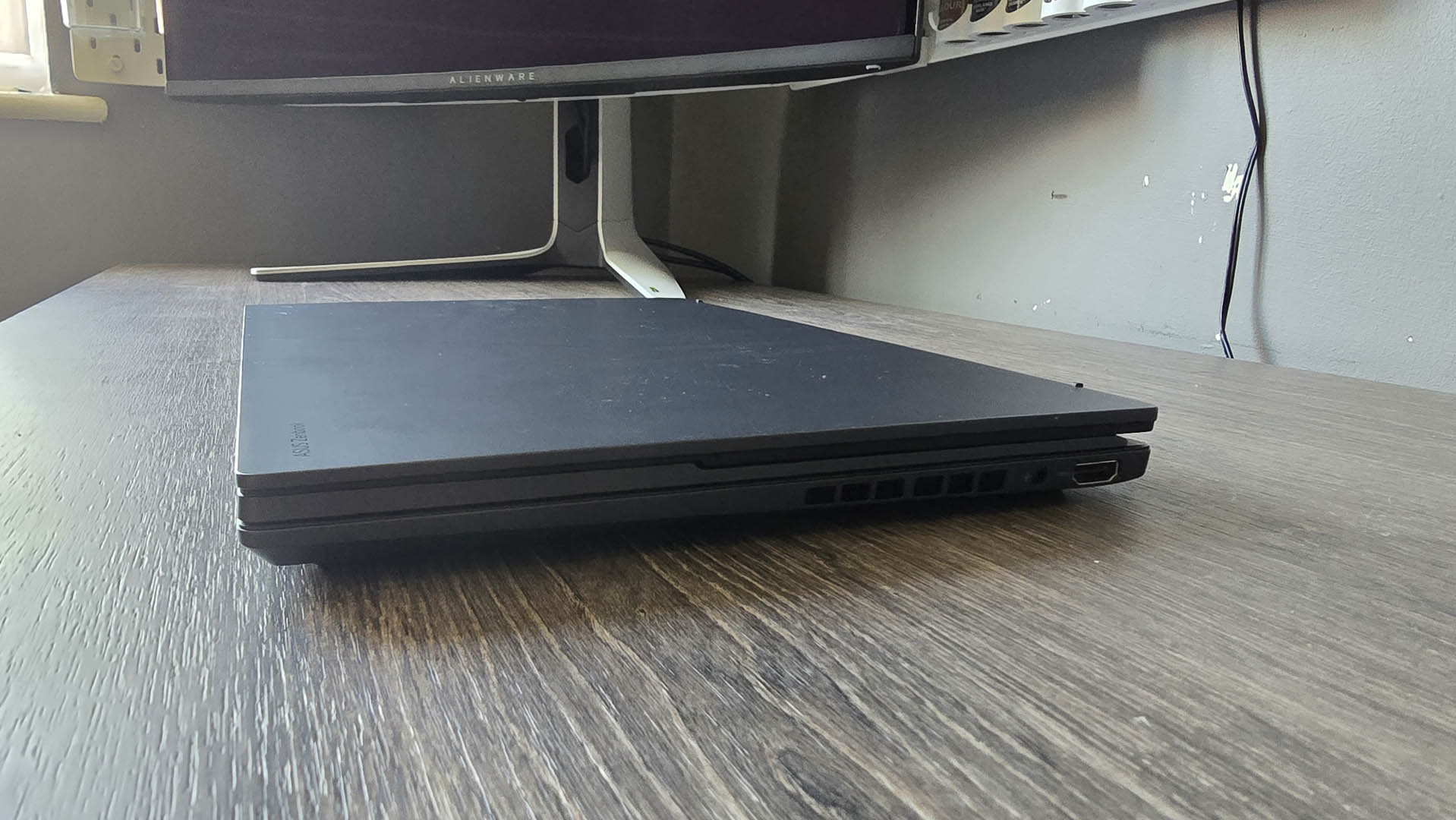
Other specs include 32GB of LPDDR5X soldered memory clocking in at an impressive 7,647MHz, and a 2TB WD SN740 M.2 PCIe 4.0 SSD, which although hefty in capacity, does lack in some respects in terms of performance (I’ll come back to that, too).
Overall build quality is impressive, with tiny screen bezels, and the integrated webcam isn’t obtuse by any means. Asus has really done an incredible job of making this feel and act like a premium device.
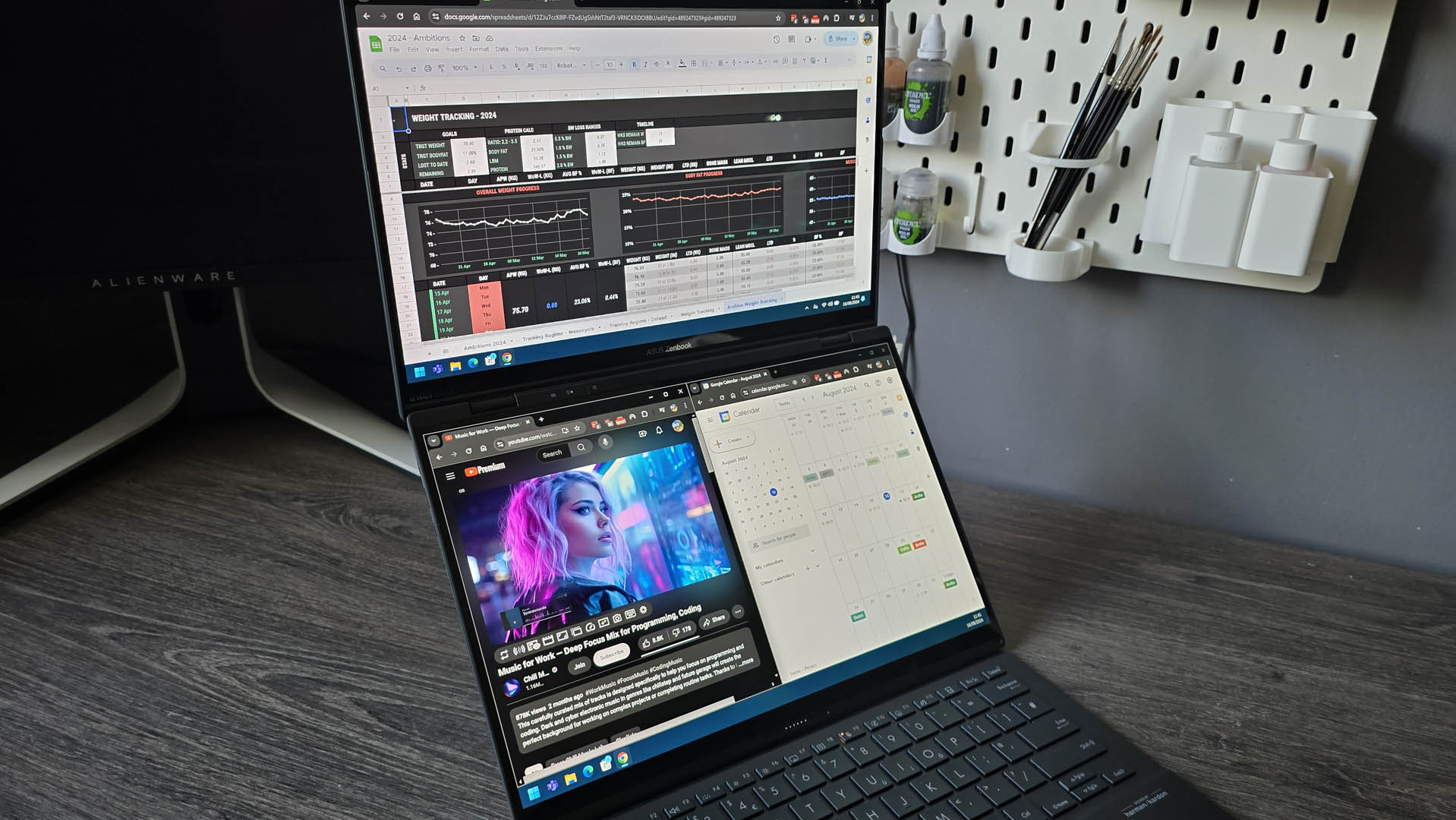
You can use the Zenbook Duo in all manner of configurations. Detach the keyboard and run it wirelessly and you’ve got a flat screen on your table, and one propped up in front of you. Alternatively, you can pop the stand out on the bottom screen (the underside of the laptop) and perch both screens up on a table fairly seamlessly. You can also disable that bottom screen entirely by positioning the keyboard on top of it too, and even flip it onto its side, and run both displays in portrait mode, side-by-side.
It’s just a fantastically seamless experience all round really, and it’s a party trick that never quite gets old. Although one thing to note: if you do flip the Zenbook so both screens are portrait, you lose access to at least some of those ports on the bottom.
- Design: 4.5 / 5
Asus Zenbook Duo (2024): Performance
- Day-to-day use is fine
- CPU throttles during longer more intense workloads
- SSD performance is underwhelming
Here's how the Asus Zenbook Duo (2024) performed in our suite of industry-standard benchmarks and game tests.
Geekbench 6:
Single - 2,330
Multi - 11,645
3DMark:
Night Raid - 23,008
Solar Bay - 11,989
CrossMark:
Productivity - 1,533
Creativity - 2,060
Responsiveness - 1,350
Overall -1,709
Cyberpunk 2077:
1080p - 17.8fps (Medium)
Total War: Warhammer III:
1080p - 16.3 (Medium)
Final Fantasy XIV:
1080p - 37.3 (Medium)
CrystalDiskMark:
Read: 5,242MB/s
Write: 4,813MB/s
Cinebench R24:
Single-core - 106
Multi-core - 429
PCMark 10 Battery Test: 8h 4m
I ran the Zenbook Duo through a gamut of tests to really weigh up its worth and see just how it performs, covering everything from longer creative CPU workloads, to gaming, to AI operations and everything between. Across the board, the Asus laptop is pretty average, which is a challenging thing to say when looking at an $1,800 laptop. Clearly the bulk of the manufacturing cost is spent on the displays.
The Core Ultra 9 185H is a hot and hungry CPU by its very design. Run the Zenbook Duo through any relatively short benchmark, like Geekbench 6 or CrossMark, and it’ll typically spit out some fairly decent numbers. Geekbench gives it a score of around 11,645, and by comparison, Asus’s Vivobook S 15, with its Arm-based Snapdragon X processor, flirts with 13,864 (19% faster) in that test. The Acer Swift Go 14, with its Core Ultra 5 125H, manages 10,809 (7% slower) as well.
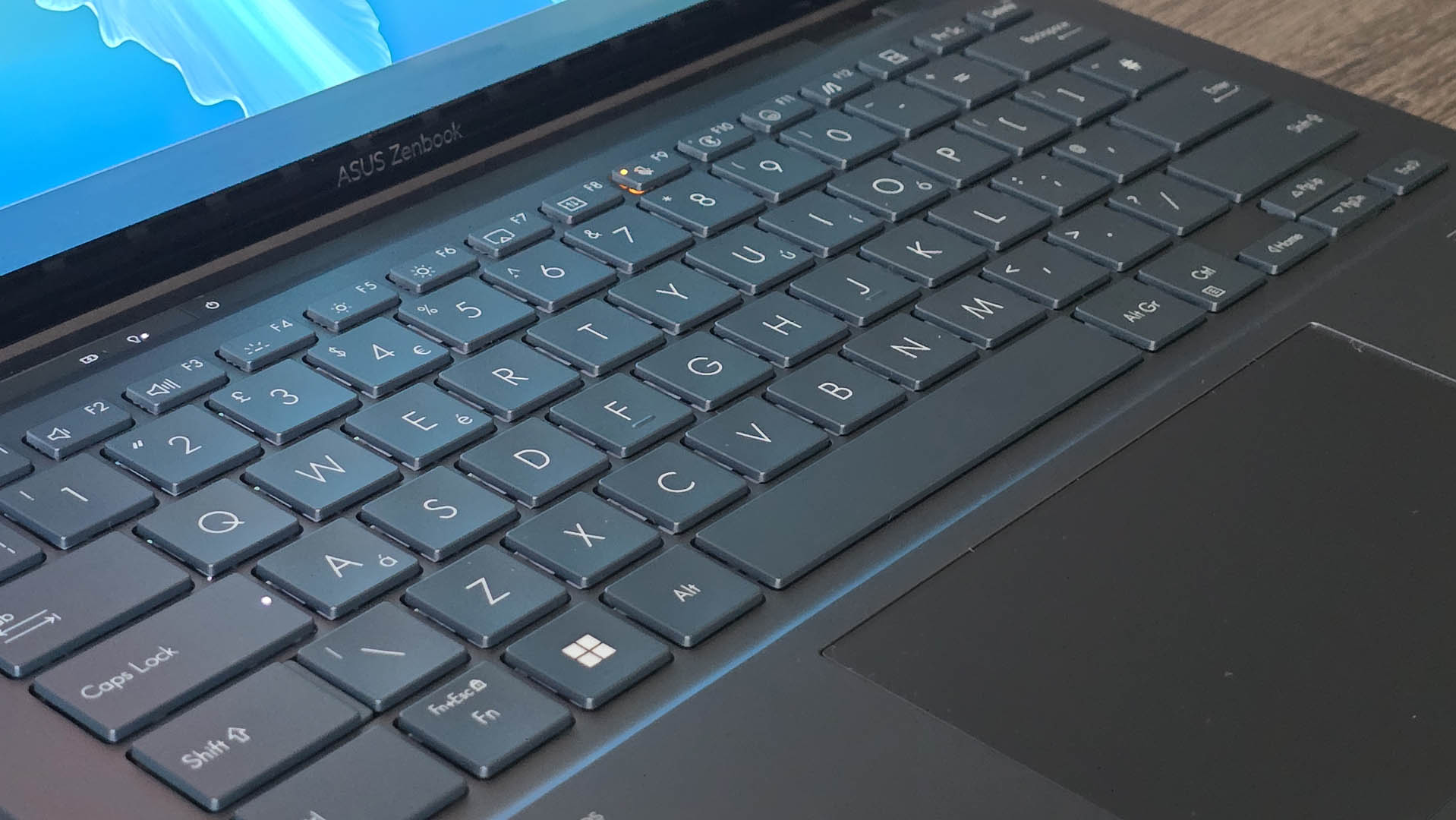
Throw something a little more intense at the Duo, though, and soon enough the heat issues become apparent. In Cinebench 2024 the Zenbook Duo scored a paltry 429 in the multi-core test. The Core Ultra 5 in the Acer Swift managed 636, and the Vivobook S 15 an impressive 925 by comparison. That is a big difference, and it’s mostly down to clock speed falling off a cliff as the Zenbook throttles under the thermal load.
Then there’s the storage. Top-line sequential figures generally come out fairly well here. The 2TB drive produces 5,242MB/s read and 4,813MB/s write speeds, about on par with an average PCIe 4.0 SSD in a laptop, most likely due to a larger onboard cache. Where it falls apart a little is in the random 4K writes. The SN740 managed only 120MB/s whereas the 500GB Kingston drive in the Swift hit 227MB/s, and the drive in the Vivobook S reached 211MB/s. Random 4K benchmarking reflects Windows and game-loading performance, so that’s not so great to see here.
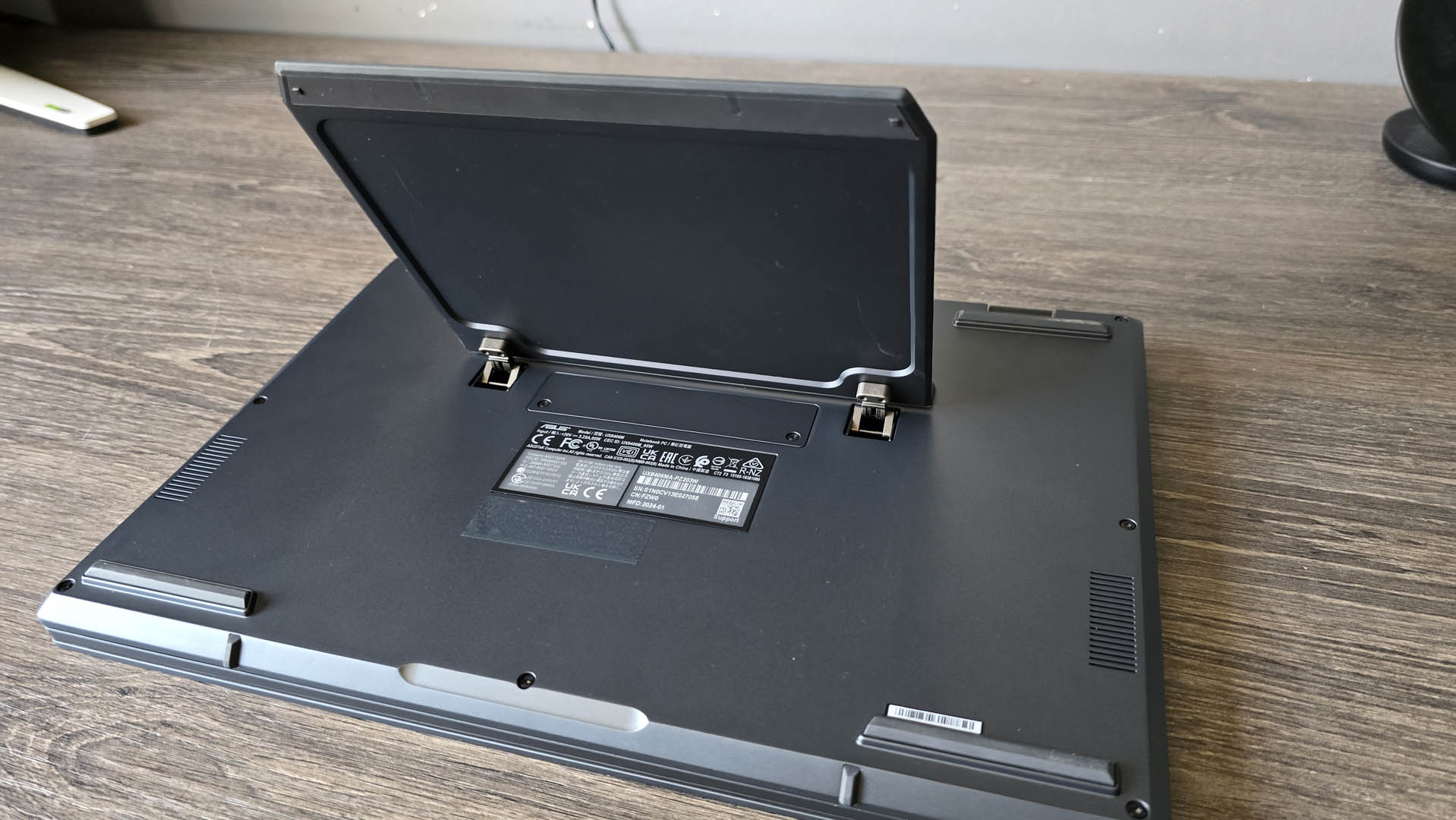
Speaking of gaming, at 1080p on medium presets, it is possible to eke out some semi-tolerable performance. Final Fantasy XIV Dawntrail managed 37.3 frames per second (fps), but Total War Warhammer 3 and Cyberpunk 2077 (without XeSS and no ray tracing) were both under the 20 fps mark. Enable XeSS and Cyberpunk jumps up to a 26 fps average, but it’s still not exactly comfortable for many modern titles. The results are predictably worse at the Duo’s native resolution on low graphical presets, with even Final Fantasy’s Dawntrail benchmark clocking in at just 22.1 fps.
For AI testing I used UL Procyon’s AI Computer Vision benchmark with Float16 accuracy. Under CPU power alone, and in Windows’ Machine Learning API, the Zenbook Duo scored just 28, whereas again the Core Ultra 5 in the Swift Go managed 32 by comparison. Matters do improve if you switch to using the integrated GPU in that scenario, with the Zenbook landing 230 versus the Swift’s 194, but it’s still not a patch on a dedicated GPU which typically reaches well above the 1,000 mark, if not much higher (an RTX 4080, for reference, nets a score of around 1,940).
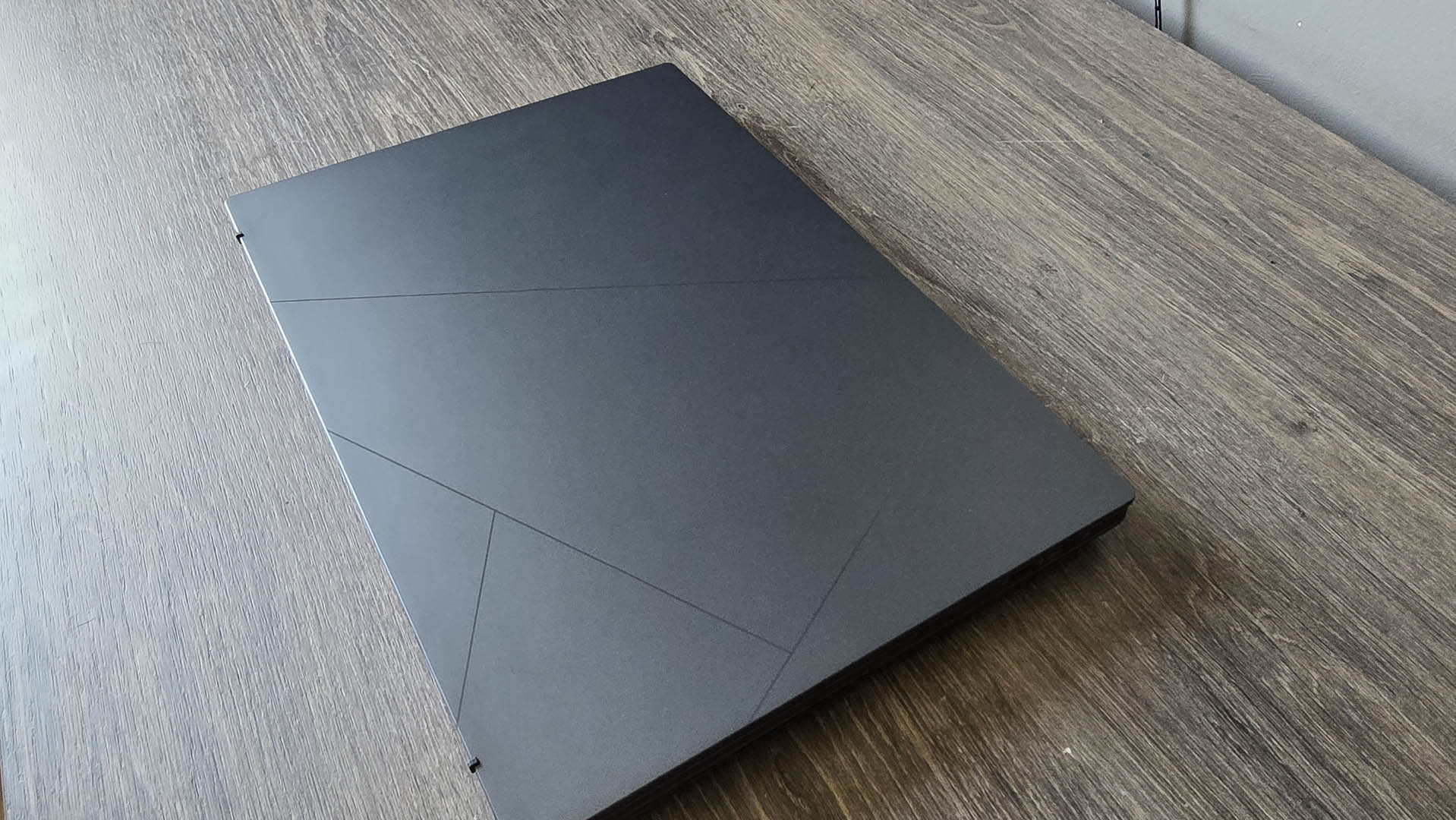
For day-to-day work then, the Zenbook Duo is a good pick. Its crisp displays and smooth desktop experience are beautiful to behold. However, if you are looking at any major rendering operation, or something that involves consistent workloads over a longer period of time, you are going to be severely limited by that Core Ultra 9 chip. Unfortunately, the difference between the Core Ultra 7 and the Ultra 9 mostly comes down to professional-grade features, rather than a reduction in core count, so you’re not likely to see improved performance with lower spec models either.
- Performance: 2.5 / 5
Asus Zenbook Duo (2024): Battery life
- Battery life is solid
- Intel chips still lag behind Arm, though
The Zenbook Duo comes with a 75WHr battery as standard, paired with a 65W charger. It’s rapid enough to charge up, although not the fastest by any means. I used the Zenbook Duo as my daily driver for around two weeks or so, and found it to be more than adequate for holding a day’s worth of charge in the office.
I also benchmarked it utilizing a mixture of tests in PCMark 10. The video test in particular, with 50% screen brightness and no audio, managed just over eight hours before the device hit 3% charge. Gaming, as you’d probably expect, was far more demanding (and tested at 75% screen brightness), lasting for only a smidge over two hours before meeting the same fate.
That’s not bad, all things considered – and the fact Asus has even managed to cram in a 75WHr battery is nothing short of impressive. The Acer Swift, which has a 65WHr battery (about 13% smaller), only lasted for six hours in PCMark’s video test. Still, in both scenarios those are solid numbers, certainly for laptops with x86 chips. Neither of them, however, hold a candle to the Snapdragon X Elite in the Vivobook S 15, which lasted a phenomenal 12 hours.
- Battery: 3.5 / 5
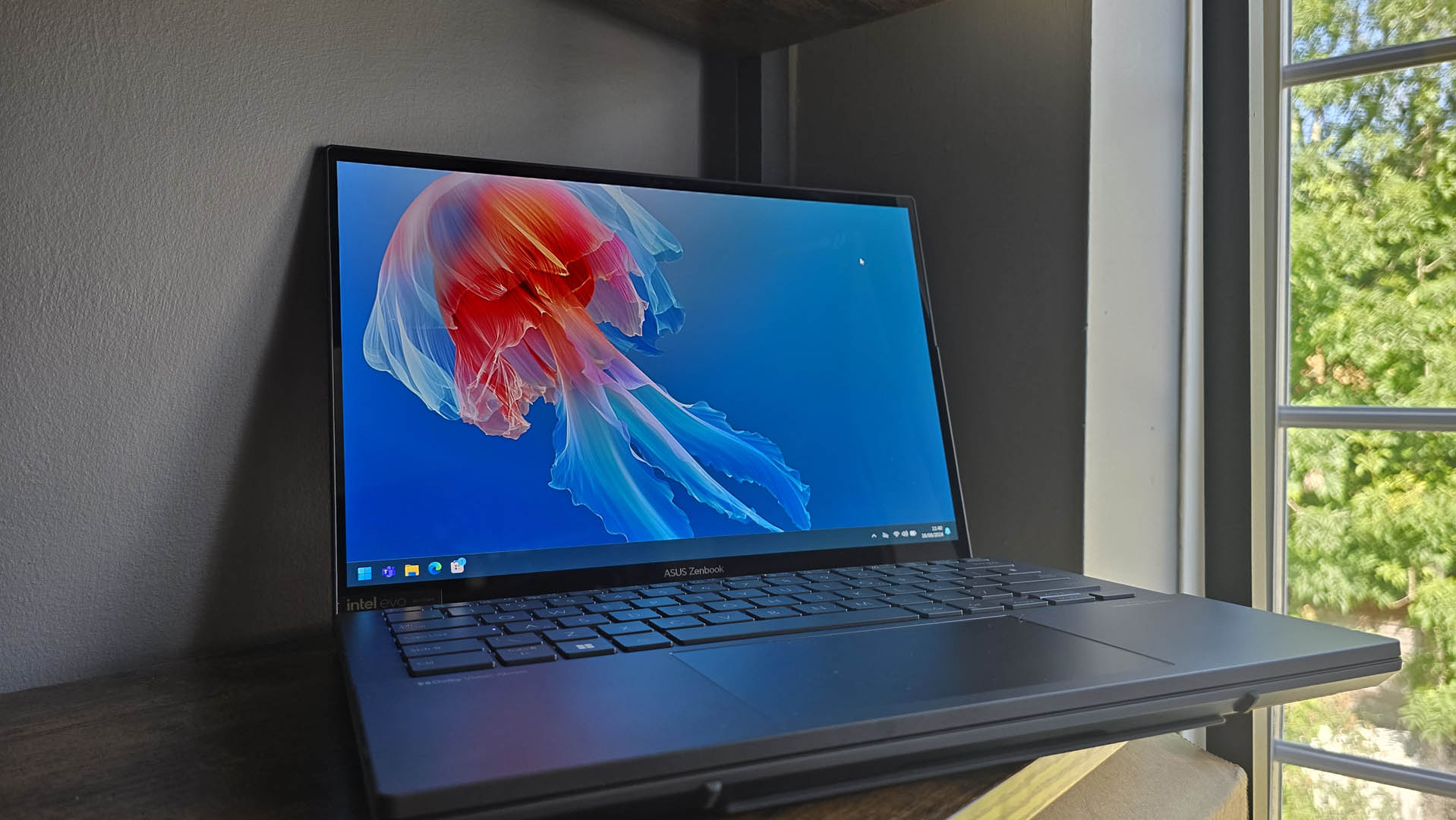
Should you buy the Asus Zenbook Duo (2024)?
| Attributes | Notes | Rating |
|---|---|---|
| Price | The Zenbook Duo is surprisingly well-equipped given the price. It’s not flawless, but the drawbacks mostly come down to sustained performance – if the cooling was better this would be a big win. | 4 / 5 |
| Design | There’s no denying the flexibility in those screens is something else, and the overall look and feel of the whole laptop is beyond premium. | 4.5 / 5 |
| Performance | Let down by its cooling, and providing a miserable gaming experience, the Core Ultra 9 is sub-par at best for handling anything that isn’t a Word document. | 2.5 / 5 |
| Battery | Battery life sits on the cusp of being great for an Intel chip, but sadly it still doesn’t hold a candle to the Snapdragon X’s dominance. | 3.5 / 5 |
| Average rating | The Zenbook Duo is a thoroughly interesting device. Those two vibrant displays and how they operate is certainly unique, but thanks to some middling cooling, performance is seriously sub-par for the price you’re paying. | 3.5 / 5 |
Buy it if...
You’re looking for a versatile notebook with stunning screens
There’s no denying those twin 3K OLED panels are phenomenal to look at, with high refresh rates, a solid response time, and beautifully crisp colors. These screens themselves make the Zenbook Duo a tempting proposition.
You want a premium notebook ideal for office productivity work
The Duo is perfect for those looking for a Windows alternative to a mid-range MacBook. It might not have the clout of an Arm processor, but if you’re not into that, this Zenbook will have you covered.
Don't buy it if...
You’re a creative with longer, more demanding, workloads
Rendering video? Working with large datasets? Managing AI workloads? This isn’t the laptop for you. Thermal throttling seriously hinders its overall performance by no small margin.
You’re looking for the best battery life
Similarly, Intel’s Core Ultra series may be better than its past mobile CPU offerings, and those from AMD, but Meteor Lake still doesn’t hold a candle to the Snapdragon processors now out in the wild.
Asus Zenbook Duo (2024): Also consider
Asus Vivobook S 15 Copilot+
It’s the Arm-based Snapdragon chip in this notebook that really dominates in performance terms, but it’s all bundled together with a beautiful design, plus phenomenal pricing.
Read the full Asus Vivobook S 15 Copilot+ review
Acer Swift Go 14
This laptop is far more affordable than the Asus Zenbook Duo. What it lacks in extra screens, it makes up for with stellar performance for the price – plus it’s still an OLED display here, too.
Read the full Acer Swift Go 14 review
How I tested the Asus Zenbook Duo (2024)
- Used the laptop for two weeks as my daily driver
- Tested it for work and gaming
- Ran a whole gamut of benchmarks
With all the laptops I get in for review, I aim to use them for at least two weeks as my daily driver, answering emails, using them for work, doing a bit of light content streaming (Netflix, YouTube and Spotify), as well as some light Photoshop work and gaming too. I also run them through a myriad of benchmarks designed to push the laptops to the absolute limit of their potential, to ensure that they perform well in any scenario, not just day-to-day office use.
I’ve been reviewing laptops and PCs for well over nine years now, and have evaluated many, many devices in that time. Intel’s Core Ultra chips are certainly a step in the right direction, but I can’t help but feel that the time of x86 chips might be coming to an end.
- First reviewed August 2024

Zak is one of TechRadar's multi-faceted freelance tech journalists. He's written for an absolute plethora of tech publications over the years and has worked for Techradar on and off since 2015. Most famously, Zak led Maximum PC as its Editor-in-Chief from 2020 through to the end of 2021, having worked his way up from Staff Writer. Zak currently writes for Maximum PC, TechRadar, PCGamesN, and Trusted Reviews. He also had a stint working as Corsair's Public Relations Specialist in the UK, which has given him a particularly good insight into the inner workings of larger companies in the industry. He left in 2023, coming back to journalism once more. When he's not building PCs, reviewing hardware, or gaming, you can often find Zak working at his local coffee shop as First Barista, or out in the Wye Valley shooting American Flat Bows.
